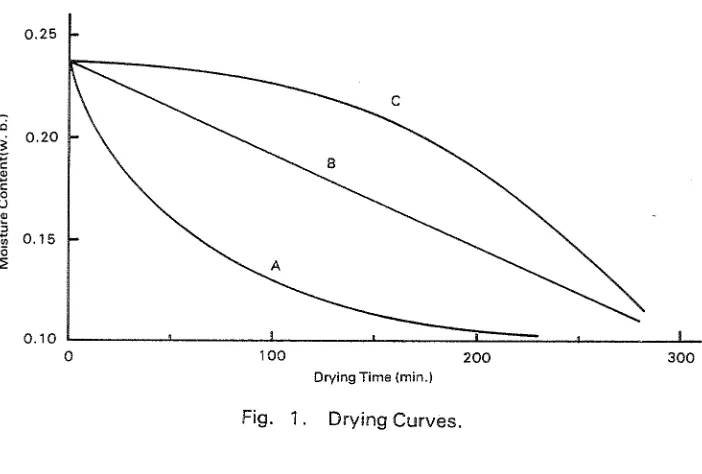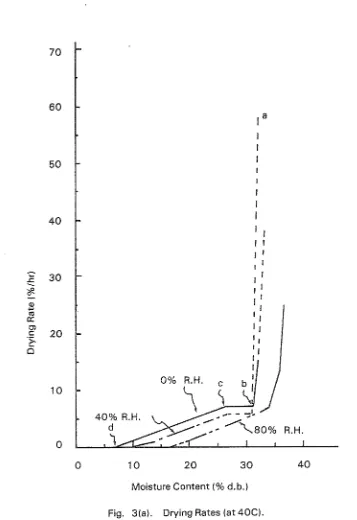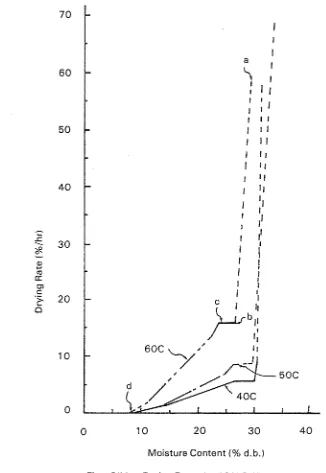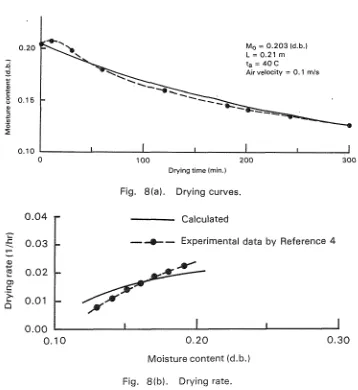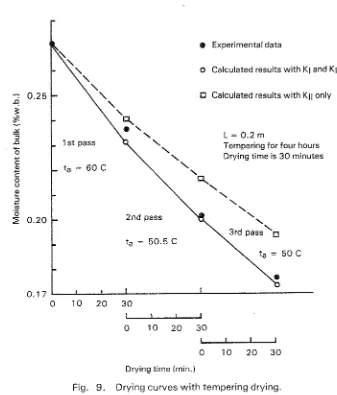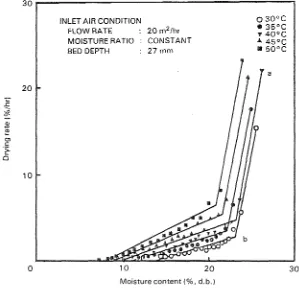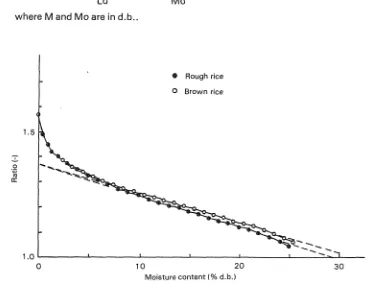ON DRYING OF ROUGH RICE
-
RECENT TRENDS IN RESEARCH AND PRACTICE IN JAPANDepartment of Agricultural Engineering, Utsunomiya University, Utsunomiya, Japan
ABSTRACT
Drying of rough rice is the first step following harvesting for preservation of quality and quantity of rice as food as well as seed. Drying, in fact, is a simple operation, i.e. removing water from rice. It is not however so simple as squeezing water out of a wet towel. A little closer look reveals that drying of rough rice is quite complex and that a multitude of problems remains yet to be answered.
First, a brief historical sketch on mechanical drying of rough rice in our country is given. Then the results of the research are presented which has been made in the Laboratory of Agricultural Processing Enginsering at the Department of Agricultural Engineering, University of Tokyo.
New work and new development in the same laboratory which took shape after my retirement will be presented with comments.
Comments will further be given on how soon the drying should be finished, on rewetting of test samples and on computer simulations of drying processes.
Finally some of the new features of rice driers which have been made available for farmers recently in our country will be discussed.
INTRODUCTION
Drying of rough rice, or any other grains, is the first step following harvest- ing for preservation of rice as food as well as seed. Drying, in fact, is a simple operation, i.e., removing water from rice. It is not, however, so simple as squeezing water out of a w e t towel. A little closer look a t it reveals that drying is quite complex and a multitude of problems remains yet t o be answered.
either liquid or vapour. This shool concerns more in mechanism of drying than in design of driers, although the ultimate goal of both schools may be the same.
Whichever school we may be in, however, knowing on the one hand such drying characteristics of rice specific heat, heat and mass transfer rates between rice and drying air, and on the other, the drying air conditions such as its temperature, humidity, air volume and bulk density of, or air pressure loss through, the rice bed, we my be able t o set up a mathematical model of rice drying. These models will enable us to predict the temperature and moisture distribution through out the bulk, the average moisture content of the rice bed at any instant of time, variation of moisture between the top and bottom layers and how soon the given amount of rice will dry and so on. Further those models enable us t o simulate drying rocesses on computers in search for better drying operations. Computer simulation has become a powerful engineering tool of drying these days.
BRIEF HISTORY OF RESEARCH ON RICE DRYING IN JAPAN
Mechanical driers first entered in Japanese agriculture in later years of 1920's. Around 1935, they won government subsidies and started to spread. But the popular use of driers by farmers took place only after 1 9 5 6 .
After World War il, Japan suffered acute shortage of rice. The problem was at its worst in the off-season (August and September). The government encouraged earlier delivery of rice before certain dates, e.g., August 31 or September 30. Under such circumstances farmers had not enough time for sun-drying of rice, and, therefore, rice tended to be of higher moisture contents than the government specification ( 1 4% or 1 5% w . b.). The penalty t o excess moisture more than off-set the premium. There arose a demand for simple, inexpensive mechanical driers t o meet this problem.
The pioneering work on rice driers was carried out then by T. Watanabe and his colleagues at Kohnosu Agricultural Experiment Station, which lied 30 k m north of Tokyo. They used several layers of trays, 1 5 x 1 5 cm2 with 2 cm deep rice bed, to determine the drying characteristics of rice. Their experiments were carefully carried out and their data are highly reliable ( 1 ) *.
from about 1 6 - 1 8 % (w.b.1 to 1.4-15%, at which the government purchased.
There are hundreds of research done and reported on rice drying in Japan since then, but here 1 only mention another minutely carried out experiments in early days. T. lchimura of Central Electrical Power Research Institute used box trays, 19.8 x 9.1 em2, with 3 cm deep rice. He carefully controlled the inlet air humidity using a rather expensive humidifier (4).
After 1965, rice combines came t o use. Rice was then harvested at 20-
2 5 % (w.b.) and sometimes in northern Wonshu, at 25-28%. Conventional batch-in-bin driers could not handle rice with such high moisture. It took too much time t o dry. Air temperature had t o be raised, and air volume had to be increased. Then the bottom layers tended t o overdry and to develop checks in kernels while the top layer was still wet. Vertical recirculating driers, then,'were introduced. This type incorporated the idea of tempering, the upper section of the drier serving as a tempering tank. These vertical rice driers are a common sight when you visit Japanese farms to-day.
A t about the same time, the US type country elecator was introduced in Japan t o handle a great quantity of combine-harvested high-moisture rice at farmer's cooperatives. Especially Hachiroh-gata, Akita, the northern district of Monshu, where a lake had been drained and 6,000 ha of land had been reclaimed for wet rice field, was just going to produce rice in a year or two. One rice elevator was expected t o dry 5,000 tons of rice for 25 days. The govern- ment set up a committee t o look for a suitable drier to handle 200 tons of rice a day. After all, the committee decided on adaption of non-mixing columnar continuous flow drier with a pair of 20 cm screen spacings. The holding capacity of the drier was 1 2 tons and t w o driers were installed in an elevator. While 1 was working, as a committee member, on a model test drier, I noticed that any shape of drying curves could be obtained simply by changing combination of air temperature and humidity and the thickness of rough rice layer, as shown in Fig. 1. Then I wondered what the true drying characteristics of rice would be.
on drying was not cleared. The only solution seemed t o use a single grain as the minimum unit of bulk for determination of drying characteristics. It was not I alone that came t o the similar idea. I personally know t w o researchers who attempted the use of a single kernel without success. It took me a year t o come t o the experimental apparatus shown in Fig. 2. Thus Motohashi and I set out for single grain experiments.
100 200
Drying Time (min.)
Fig. 1. Drying Curves.
The experiments were carried out during 1969-72, in the Laboratory of Agricultural Processing Engineering at the Department of Agricultural Engineering, University of Tokyo 15).
The heart of the apparatus is a slender glass beam, about 900 m m long and 0.2 m m in diameter at its hook end. A piece of Corning Pyrex glass tube,
[image:4.514.76.427.175.412.2]the screw end of the beam was lowered by 0 . 5 m m or 0.1 mm, for instance, and the time for the grain t o come up t o the hair line in the viewer was measured. From the calibration curve of weight versus deflection of the beam, which was almost linear, the weight loss for a certain time interval was read off, and hence the drying curve was drawn, from which the drying charac- teristics were determined.
A single grain of rough rice weighed 3 0 - 4 0 mg. Variety used was Nihonbare, Japonica type. I n combination w i t h the least count of 0 . 0 1 m m of the travelling microscope, the beam gave the least reading of 2 p g. The sensitivity of the weighing apparatus, therefore, 2 p g I ( 3 0 - 4 0 ) or I /
17,500, allowing us t o detect easily 0 . 1 % change in moisture in the kernel. The grain buoyed up in the air stream about 1.2 mm, but this was almost constant during drying as long as the air velocity was kept constant. Grain was the air velocity was kept constant. Grain was stable in the air current when the air flow velocity was 1.5 m/s or less. One run of experiment took between 1 0 and 30 hrs, average being 1 5 - 2 0 hrs.
Air was supplied from a compressor tank. The flow was regulated by a two-stage pressure regulator. The flow rate was measured b y a rotameter and could be set at any desired value between 1.5 t 0.01 and 0.05 t 0.005 m/s. The air was first cooled down t o - 4 0 6 and was removed of its moisture. Then the temperature was raised by electric heaters and a calculated quantity of water was added t o the air stream b y slowly pushing the piston of a hypoder- mic syringe. This method enabled us t o control the quantity of water supply steplessely between 0 . 2 - 6 0 cc/hr w i t h the maximum error of 0 . 0 2 cc/hr. Thus the relative humidity of drying air was kept w i t h
+
1.0% accuracy.0
1 0 2 0 3 0 4 0Moisture Content ( % d.b.1
[image:7.514.75.432.39.559.2]0 10 2
0
3 0 40Moisture Content ( % d.b.)
[image:8.514.67.393.77.550.2]have not space t o mention, constant rate of drying of a rough rice grain was measured (7). The sample grain was well moistened in water so that the surface of it was covered witti thin water film. The constant rate of drying is, by definition, the rate of water vaporization from free water surface. It depends on air conditions and also air velocity passing on the water surface, but there should be no such distinction between the constant rate of free water and of grain. Therefore the constant rate of drying w e measured is not a rice characteristic.
One run of experiment finished in 1 - 3 minutes, during which 6 - 1 0 readings were taken. The amount of water removed from rice surface during this period was well summarized in the following Ranz-Marshall form
Nu = 2.0 f 0 . 7 4 Pr1I3 Re1/'
which was very close t o the Ranz-Marshall equation for a sphere, Nu = 2.0 f 0 . 6 0 Pr1I3 Re"'.
This result, together with the one from (2), assured us t o treat rice grains in the bulk as spheres. Many researchers had treated rice as spheres without these warrants.
(4) When our drying characteristics were presented as Fig. 4, the drying constant for the period I (a
-
b),K1,
and for the period I / (c-
dl,K I I ,
were given, asKI
= 0.0339ta - 0 . 3 4 6K I I
= 0 . 0 1 53ta-
0 . 2 1 5Constant rate Rc
---
d Moisture Content
[image:9.518.113.416.325.588.2]where K is defined as
(5) When no more reduction of weight was observed for 2-4 hours towards the end of the experiment, the experiment was terminated. The final moisture content of the grain was taken as the equilibrium moisture content at the air conditions under which the experiment was made. This is what is called the dynamic equilibrium moisture content and was given as
Me = 0.1 70e-0.04011ta-t~)
APPLICATION OF SINGLE GRAIN DRYING CHARACTERISTICS TO BULK
Professor Toei of Department of Chemical Engineering, Kyoto University developed an analytical method of calculating drying processes taking place in through-air drying of a granular bed during a 1965- 1966 period
(8),
as if he would offer us a.proper method for our rice drying calculations. We approxi- mated the drying characteristics of granular materials to two line segments as shown in Fig. 5. This approximation, he claimed, was valid for most granular materials of 3 - 5 rnm sizes in diameter. Further assumptions are needed in calculation as follows.(1) The initial moisture content and temperature of the granules were the same and uniform throughout the bed.
(2) The inlet air conditions should remain constant throughout during drying. (3) The problem was treated as one dimensional in the direction of air flow, Fig.
6.
(4) No shrinkage of particle sizes would occur during drying.
(5)
Drying process through the bulk is adiabatic.Our drying characteristics of rough rice could be approximated to df in Fig. 7 to conform to Toei's assumption by extending dc, and assuming that drying would begin at g. This neglect of the first period of large drying rate (a - b) may throw us off with errors but may not be seriously wrong because the first period took only 1 - 2% of the total drying time. We used Toei's equations and calculated local moisture content and the average rate of drying of the bed as regards to drying time (9).
0
M - M e=
7
Mc
-
MeFig. 5. Non-dimensional Drying Characteristics.
M(z,8) : Local moisture content
-
a
: Local rate of dryinga
e
~ ( 6 ) : Average moisture content.
d w
-
d
e
: Average rate of drying [image:11.514.88.446.72.349.2] [image:11.514.74.446.73.620.2]The results for deep beds were quite satisfactory but it turned out that the results of our equations for drying with tempering were rather off the experimental data. Drying with tempering is a process is which a pass consisting in drying and tempering is repeated 3 to 6 times to complete drying in such a ray that half an hour's drying with rather high temperature air and high air volume is followed by tempering, viz., storing rice in a tank "For at least 4 hoyrs. The overall rate of dr\/ing including tempering time is 0.5- 1.5% (w.b.)lhr, but the drying itself takes place with a rate as high as 3-6%/hr in a columnar continuous flow drier.
Because one drying pass terminated in half an hour, Motohashi thought it necessary to take the first large rate of drying into account. He modified the drying characteristics to a-e-c-d in Fig. 7, and also incorporated both Period I and Period
I!
into Toei's equation. Then he showed that the modified equations could successfully calculate the tempering drying process as shown in Fig. 9 (10). There were a few investigators who tried to explain the tempering process by water diffusion models through a sphere, but Motohashi was the first who offered a satisfactory way of calculating the drying with tempering based totally upon his experimentally determined drying characteristics of rough rice.Me
Moisture Content (d.b.1
[image:12.514.84.434.320.565.2]0.20 Mo = 0.203 (d.b.1
-
L = 0.21 mt, = 40 C
:
Air velocity = 0.1 mls+ 0 ) +
0.15 e
C(
.-
9
Drying time (rnin.)
Fig. $(a). Drying curves.
r
Calculated-
I5
0 . 0 3-
Experimental data by Reference 4'C
-
Moisture content (d.b.1
Fig. 8(b). Drying rate.
[image:13.518.76.434.64.454.2]@ Experimental data
0 Calculated results with K I and Kll
El Calculated results with Kll only
L = 0.2 m
Tempering for four hours Drying time is 30 minutes
ta = 50.5 C
Drying time (min.)
Fig. 9. Drying curves w i t h tempering drying.
RECENT DEVELOPMENT BY DR. KAMEOKA
[image:14.514.77.414.59.454.2]ments on thin layer drying as well as deep bed drying. Based upon his own data, he set up a mathematical model of water diffusion through the starch core of rice kernel to husk and from husk into passing air in each of a series of thin layers of a deep bed. From his work a few topics of interest may be offered. ( 1 ) In his thin layer experiments in which be used 7, 17, 2 7 mm thicknesses, he observed the initial large rate of drying, as shown in Fig. 10, which was almost identical with Fig. 3. Kameoka took readings every 1 0 minutes for the first one hour of his drying, every 2 0 minutes in the following 4 hours and after that every half an hour, and with this frequency of observation, he could detect the initial period of large drying rate. Watanabe ( 1 ) took his first, second and third reading 1 0 minutes, 30 minutes and 5 0 minutes after the start of the experiment with a 2 cm layer respectively and lchimura (4), 5, 7 5, 2 5 minutes with a 3 em layer respectively, but both of them failed t o observe the first period. I should like t o know why ~ a k e o k a was successful in arresting the first period, whereas others failed.
INLET AIR CONDITION
FLOW RATE : 2 0 m2/hr MOISTURE RATIO : CONSTANT BED DEPTH : 2 7 m m
10 2 0
Moisture content (%, d.b.1
[image:15.522.97.396.282.575.2]Kameoka took one and plus readings for the first period with the maximirm rate of 1 8
-
25% Id.b.)/hr, whereas Motohashi took6
-
1 5 readings with the maximum rate of 5 5 - 6 8 % as can be seen in Fig. 3. Also Kameoka lacks in humidity effects. Even though he wants information that correlates thin layer data with ones of a single grain, he way have demonstrated a possibility of replacing rather difficult single grain experiments with thin layer experiments.(2)
It was well known that the heat of water desorption was greater than the heat of evaporation of water and a good discussion on this topic couid be found in old textbooks ( 1 2). ~ e t a i l e d data on rice, however, were unknown. Were Kameoka presented a good experimental result with theoretical consid- erations, Fig. 1 1. In our drying range of rice moisture, the ratio is 1 .O- 1.2. The data will certainly be used with benefit in our computation.'(3) Shrinkage of rice during drying has been quite obvious but no one ever gave quantitative relations on this phenomenon. Kameoka gave he following from his deep bed drying experiment.
L
--
-
0 . 1 3 2 ~ -Lo Mo
+
0 . 8 6 8where M and Mo are in d.b..
@ Rough rice
0 Brown rice
10 20
Moisture content ( % d.b.1
[image:16.524.65.436.288.572.2]SOME OTHER TOPICS
H o w Soon Should Rough Rice be Dried?
Fifty-five percent of the rice are harvested by combine these days in Japan w i t h moisture contents of about 20-25.%. The government recommends t o start drying within 4 hours after harvest, before microorganisms start their activities, especially when the outdoor temperature is above 206. You will certainly feel heat and smell due t o incidence of fermentation when you put your hand in a sack of high moisture rice 4 or 5 hours after harvest. It is our common practice t o finish up drying in a drier within 2 4 hours for the next batch of rice that will be harvested the next day. In country elevators people reduce the moisture d o w n t o 1 7 - 1 8% before the rice goes t o temporary storage. But I know a case reported that in deep bed of 83 cm, the top layer got moulded in 5 days before the entire bed dried. In batch-in-bin drying, deep rice as 2.5 m may require 2 0 days t o dry under favourable weather and sometimes more during bad weather.
Aflatoxin development must be carefully avoided. Corn (maize) seems particularly susceptible t o contamination by aflatoxin producing microorgan- isms. I noticed that a good number of research was going on i n the ASEAN countries i n this line, when I attended the Postharvest Workshop a t Puncak last year. Ross ( 1 3) developed a model t o specify the necessary time within which drying should be finished t o avoid aflatoxin production i n corn. It is fortunate that rice is much less attacked by aflatoxin p r o d u c i ~ g fungi ( 1 4), but I know a case in imported rice from one of the Southeast Asian countries in postwar years which caused a serious political trouble at that time. Similar work t o Ross's on rice seems very necessary, especially for tropical regions, t o inform us how soon w e should complete the drying of rice.
Rewetting sf Sample Rice
Computer Simulation
Computer simulation is, as I mentioned, a powerful engineering tool for us. Experiment on a computer for different set of air conditions and other data is much quicker in time with less labour. It is also economical. It allows us t o repeat hundreds of runs of experiment. Because our goal is pretty clearly set, such as obtaining the most desirable drying curve, or reconstructing our experimental data, when our computation goes awry w e simple make changes in time interval or thickness of the layer, until our results become reasonable. Actually however 1 myself experienced that the drying curve had a hump like of a camel. Both Kameoka and Nishiyama told me that they had cases in which the computational result diverged. But I have not come across with reports on computational failures. If w e had a rule in our computer simulation that assured us proper convergence and appropriate accuracy, w e would be able t o conduct our computer experiment w i t h more confidence.
(a) First, w e may have t o find out whether such a principle exists or n o t as t o ensure us the proper result of simulation.
(b) Then, w e may be able t o find a guide t o assure us the convergence of computational results.
(c) Thirdly w e may be able t o find a rule t o govern how closely our computation results approach the true experimental data, or t o give us something like the confidence interval ( w i t h probability) in which the true drying curve may likely t o fall.
RECENT TRENDS IN DRIERS
Environmental Pressures on Rice Driers
Creeping urbanization into rural areas has blurred the demarcation between residential and farming areas throughout Honshu. In many places w e t rice fields are surrounded by houses. The dust coming out of driers is a source of complaints and troubles t o neighbouring houses. The dust stains laundry in the sun or accumulates on window frames. It gets into rooms or onto tables. Fan and burner noises are disturbing t o neighbours's sleep at night then otherwise the world is silent.
Makers are elaborating on dust collectors of individual small driers as well as of big driers in country elevators. Especially in country elevators of rice centres, a huge w e t type dust collector is installed into which is connected a number of dust collecting pipes distributed through the plant. The dust collector sometimes amounts t o 5
-
10% of total construction costs.time, and also neighbours are asleep, and starts up the drier automatically in the morning. The drier uses the 4-8 hour night time for tempering.
These measures for well-being of neighbouring people are costly but so far there seems no other ways of getting along w i t h them except these some- what costly measures. Environmental pressures are increasing these days.
Large Vertical Recirculating Driers
Capacities of vertical recirculating driers have been 1 -5t, 1 - 2 t capacity being most popular. I n the last f e w years, large vertical recirculating driers of 2 0 t holding capacity are partly replacing vertical columnar driers, without clear-cut reasons or advantages.
Air gates are vertically arranged, and when the loading rice reaches t o the lowest gate, is lets the air in and the drying begins. When the rice reaches the second gate, the depth up t o the second gate will be o n drying, and so on. Gate operation is automatic. I n fact the incoming rice is weighed b y an automatic weighing hopper, and while it is weighed, the moisture content of the 5 0 k g of hopper rice is determined by a dielectric meter installed in the hopper. The results are stored in memories of a small computer and used for automatically adjusting drying conditions and automatically shutting up the drier.
Automatic controls are fancy, but the provision of the drier with many air gates or shutters, and sometimes many air ducts in order t o incorporate the reversing direction airflow drying method, which will come i n the next section, make the drier very complex. The appearance of the drier gives me an impression that this new type is somewhat against the basic principles of drier design; simplicity and balanced proportion.
Several makers are manufacturing similar driers. These driers will have t o demonstrate their operational and especially economical advantages over the conventional ones.
Reversing Direction
Airflow DryingFour years ago one company installed a reversing direction air flow drier in an country elevator. Rice bed is sandwitched between t w o air chambers and the thickness of the rice layer is
750
mm. Air is alternated but the frequency depends up the initial moisture. The company recommends an interval of 5-
6 hours for 2 5-
2 6 % initial moisture rice.The same company now manufactures circular bin driers of 2 0 t capacity w i t h double walls so that the reversing direction airflow drying may be possible.
There is a recent report on this topic (1 6). They used 30.5 c m deep fixed bed consisting of
6
aalminium square trays with wire mesh at the bottom. They reported that the reversing direction airflow drying was effective in reducing the differences in the final grain moisture gradient for better quality with a 10% increase in energy consumption and corresponding decrease in drying efficiency. They recommend low temperatures (35-43.361 and high air volume (0.69-0.92 m3s-' t-') with reversing airflow only once during their complete drying period of8
hours.To achieve uniform drying through the bed, we either move rice conti- nuously or intermittantly or we can change the air direction. Comparative studies among various methods seem neccessary again for better quality of
rice and for improving economy of drying.
NOMENCLATURE
K
: Dwing constant, 1 IhrK1 : Drying constant for period I, 1 Ihr
K I I
: Drying constant for period II, 1 Ihr L : Depth of bed, mLo : Initial depth of bed, m
M : Local moisture content, %(d.b.) Me : Equilibrium moisture content, % (d.b.1 Mo : Initial moisture content, % (d.b.) Mu : Nusselt number,
-
Pr : Prandtl number,
-
R
: Rate of drying, 1 IhrRc : Constant rate of drying, 1 Ihr Re : Reynolds number,
-
t a : Dry bulb air temperature,
G
t w : Wet bulb air temperature, Cw : Average moisture content of bed, % 4d.b.)
z : Vertical coordinate, m
8 : Time, hr or min.
REFERENCES
1. T. WATANABE AND H. SHIMIZU (1957). Artificial drying of Rough Rice. J. of JSAM* 1 2 (3, 4 ) : 1 1 - .
2. T. WATANABE, J. OGAWA, M. FUKUDA AND T. BAN ( I 953). On drying agricultural produce with forced air (11). Research Report 9, Kantoh-Tohzan Experiment Station, pp. 1 66-1 77.
3. T. WATANA~E AND OTHERS (1 953). On drying agricultural produce with forced air (I). Research Report 4, Kantoh-Tohzan Experiment Station, pp. 38-.
4. K. ICHIMURAAND M. NAKAYAMA ( 1 961). On drying characteristics of grains (11) (Rough rice). Re- search Report No. 2, Central Electric Power Research Institute, pp. 109-1 50.
5. A. HOSOKAWA ANO K. MOTOHASHI ( 1 9 7 1 ). Drying characteristics of a single grain of rough rice. J. of JSAM 3 3 (1 ) : 53-59.
6. A. HOSOKAWA AND K. MOTOHASHI (1 973). Drying characteristics of a single grain of rough rice for three directional postures in drying air current. J. of JSAM 3 4 (41 : 372-378.
7. A. HOSOKAWAAND K. MOTOHASHI ( 1 975). Constant rate drying of a single grain of rough rice. J. of JSAE 3 7 ( 3 ) : 326-330.
8. R. TOEI, S. HAYASHI, M. HIRAOKA AND T. YAMAMOTO (1 966). Estimating method of the rate of drying in through-air drying. Chem. Eng. 3 0 (4): 59-64.
9. MOTOHASHI AND A. HOSOKAWA (1 979). The application of forced air drying theory to deep bed drying of rough rice (I). J. of JSAE 4 0 ( 4 0 ) : 557-564.
10. K. MOTOHASHI AND A. HOSOKAWA (1 980). The application of forced air drying theory to deep bed drying of rough rice (11) : J. JSAE 4 1 (4) : 593-602.
11. T. KAMEOKA ( 1 984). Theoretical and experimental studies of rough rice drying. Unpublished dissertation, University of Tokyo.
12. C.W. HALL (1 957). Drying Farm Crops. Agricultural Consulting Associates, Inc., pp. 38-42. 13. I.J. Ross, O.J. LOWER, G.M. WHITE (1 979). Potential for aflatoxin development in lower
temperature drying systems. Trans. of ASAE 2 2 (6): 1439-1 443. 14. N.C. TEETER (1 979). Grain storage. SEARCA Publication, pp. 18-1 9.
15. A. HUSTRULID (1 962). Comparative drying rates of naturally moist, rernoistened, and frozen shelled corn. Trans. of ASAE 5 (1 1: 64-67.
